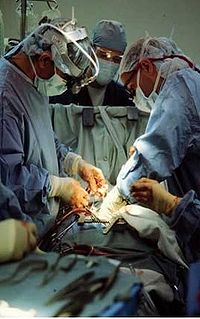
Photo from wikipedia
Background: Buerger's disease (thromboangiitis obliterans) may be a rare peripheral vascular disease that sometimes affects young male smokers. This study presents surgical treatment options for 315 Buerger's patients during a… Click to show full abstract
Background: Buerger's disease (thromboangiitis obliterans) may be a rare peripheral vascular disease that sometimes affects young male smokers. This study presents surgical treatment options for 315 Buerger's patients during a period of 18 years from 2002 to 2020. Methods: In this cross-sectional study, 315 newly diagnosed Buerger patients in a period of 18 years (by Census sampling) were evaluated. Data included age, sex, cigarette smoking status, clinical presentation, the affected limb (right or left, upper or lower extremities), and the performed therapeutic procedures such as angiography of limb arteries, amputation, sympathectomy, and vascular bypass surgery, which were collected in a data sheet. Vascular reconstruction was done if there were suitable inflow and outflow arteries. Sympathectomy was performed for the patients who were unsuitable for revascularization. All analyzes were performed using SPSSV.18 software package (SPSS Inc., Chicago, IL). Data are presented as frequency, mean ± variance (SD). Results: The mean age of patients was 42.6±9 years old, ranging from (26-75). There were 309 (98.1%) males and 6 (1.9%) females. The most common symptom was ulcer 252 (80%), and the most commonly involved arteries were the dorsal pedis (N=231; 73.4%) and posterior tibialis (N=225; 71.5%). Vascular bypass surgery, sympathectomy, and amputation were performed for patients who met surgical indications. Aortofemoral (N=9) and femoropopliteal (N=24) bypass procedures were done in 2.8% and 7.6% of patients respectively. Of nine patients who underwent aorto-femoral bypass procedure, 6 cases presented with leg claudication, 3 with an ulcer, and 3 with the Raynaud phenomenon. The digital loss rate was 9.6% (N=9) in toes and 1% (N=3) in fingers. Conclusion: As most of the Buerger patients have multi arterial involvement, bypass surgery or sympathectomy can’t help treat these patients more than cigarette smoking or pharmaceutical therapy.
Journal Title: Medical Journal of the Islamic Republic of Iran
Year Published: 2022
Link to full text (if available)
Share on Social Media: Sign Up to like & get
recommendations!